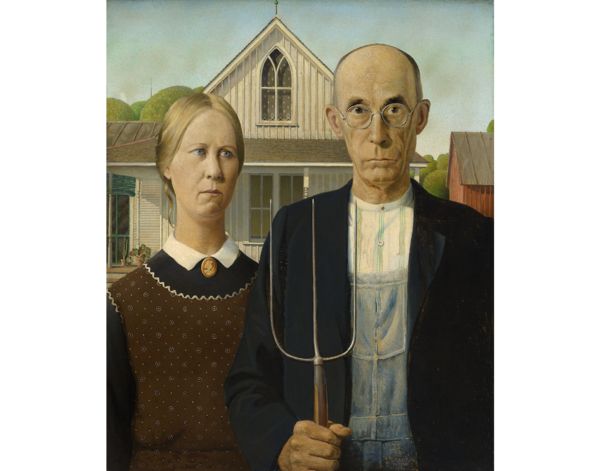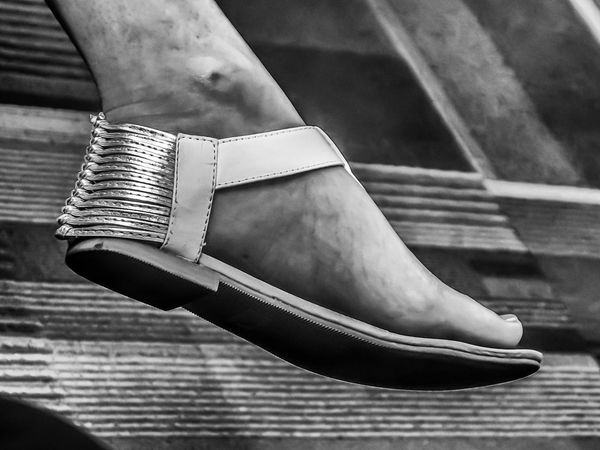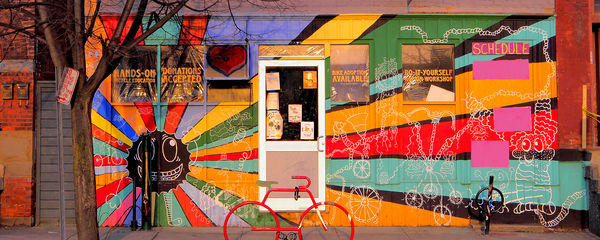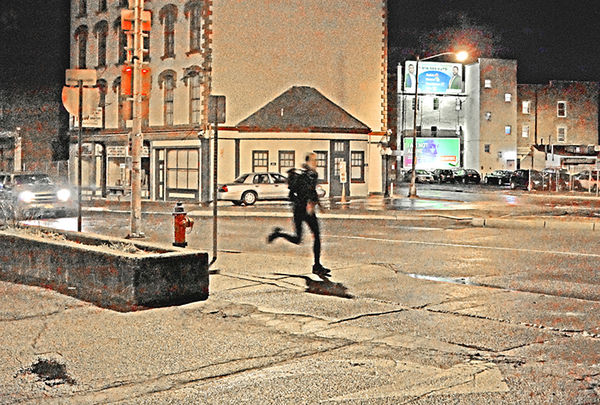Monthly Masters' Critique - January 2020 - Grant Wood's American Gothic
Dec 31, 2019 23:32:30 #
Introduction
This month we will consider an image familiar to almost everyone, Grant Wood’s painting American Gothic.
It was exhibited publicly for the first time at the Art Institute of Chicago in 1930, winning a three-hundred-dollar prize and instant fame for Grant Wood. The impetus for the painting came while Wood was visiting the small town of Eldon in his native Iowa. There he spotted a little wood farmhouse, with a single oversized window, made in a style called Carpenter Gothic. “I imagined American Gothic people with their faces stretched out long to go with this American Gothic house,” he said. He used his sister and his dentist as models for a farmer and his daughter, dressing them as if they were “tintypes from my old family album.”
Wood studied art in Europe in the 1920s then returned to his native Iowa where he became one of America’s most famous 20th century painters and is now firmly entrenched in the nation’s popular culture. Though some thought his interpretation of the couple was satirical Wood intended it to be a positive statement about rural American values and stoicism, an image of reassurance at a time of great dislocation and disillusionment.
Consider the image, then study some of the links offered below and share with us your opinion about the work. Below are some questions to stir your thinking. Answer any of them you wish to, or pursue thoughts of your own about the painting.
Questions
1. What do you think of American Gothic? The composition? The colors? The background? The execution? Would you want it on your wall? Why or why not?
2. What do you see as the message of American Gothic? Is it comedic? Is it a tribute to the stalwart survivors of the Great Depression during the dust bowl years? Do you consider it iconic? Why or why not? What is its relevance today?
3. Consider the title. What does it add to the painting? Would the painting create the same impression with a different name? Do you think it was a reflection of the architecture in the background as some have stated? Or does it moreso reflect the two human subjects? Or are both intertwined, as was suggested elsewhere? How do you feel about titles for photographs? Do you title your photos? How do you make these choices?
4. The subjects are not portrayed in a particularly flattering manner. We sometimes make photographic images that do not portray subjects in a flattering manner. Do you use touch-up or not? Does it differ if the subject is a stranger to you? Street photographers sometimes make their subjects actually look worse by emphasizing wrinkles and flaws. What do you think about this practice? Is this different than removing blemishes?
5. The internet is full of copies of American Gothic, with other people standing in for the two figures - from movie stars to politicians. Have you ever taken a photo that has some inspiration from this iconic image? If so, would you share it here?
Links for Study
https://en.wikipedia.org/wiki/American_Gothic
https://mymodernmet.com/grant-wood-american-gothic/
https://www.americamagazine.org/arts-culture/2018/04/11/grant-woods-hymns-heartland
https://maps.roadtrippers.com/stories/the-real-story-behind-the-american-gothic-painting
https://www.youtube.com/watch?v=Lf3ER5Ope_s
https://www.khanacademy.org/humanities/art-1010/art-between-wars/american-art-wwii/v/grant-wood-american-gothic-1930
https://www.artic.edu/artworks/6565/american-gothic
This month we will consider an image familiar to almost everyone, Grant Wood’s painting American Gothic.
It was exhibited publicly for the first time at the Art Institute of Chicago in 1930, winning a three-hundred-dollar prize and instant fame for Grant Wood. The impetus for the painting came while Wood was visiting the small town of Eldon in his native Iowa. There he spotted a little wood farmhouse, with a single oversized window, made in a style called Carpenter Gothic. “I imagined American Gothic people with their faces stretched out long to go with this American Gothic house,” he said. He used his sister and his dentist as models for a farmer and his daughter, dressing them as if they were “tintypes from my old family album.”
Wood studied art in Europe in the 1920s then returned to his native Iowa where he became one of America’s most famous 20th century painters and is now firmly entrenched in the nation’s popular culture. Though some thought his interpretation of the couple was satirical Wood intended it to be a positive statement about rural American values and stoicism, an image of reassurance at a time of great dislocation and disillusionment.
Consider the image, then study some of the links offered below and share with us your opinion about the work. Below are some questions to stir your thinking. Answer any of them you wish to, or pursue thoughts of your own about the painting.
Questions
1. What do you think of American Gothic? The composition? The colors? The background? The execution? Would you want it on your wall? Why or why not?
2. What do you see as the message of American Gothic? Is it comedic? Is it a tribute to the stalwart survivors of the Great Depression during the dust bowl years? Do you consider it iconic? Why or why not? What is its relevance today?
3. Consider the title. What does it add to the painting? Would the painting create the same impression with a different name? Do you think it was a reflection of the architecture in the background as some have stated? Or does it moreso reflect the two human subjects? Or are both intertwined, as was suggested elsewhere? How do you feel about titles for photographs? Do you title your photos? How do you make these choices?
4. The subjects are not portrayed in a particularly flattering manner. We sometimes make photographic images that do not portray subjects in a flattering manner. Do you use touch-up or not? Does it differ if the subject is a stranger to you? Street photographers sometimes make their subjects actually look worse by emphasizing wrinkles and flaws. What do you think about this practice? Is this different than removing blemishes?
5. The internet is full of copies of American Gothic, with other people standing in for the two figures - from movie stars to politicians. Have you ever taken a photo that has some inspiration from this iconic image? If so, would you share it here?
Links for Study
https://en.wikipedia.org/wiki/American_Gothic
https://mymodernmet.com/grant-wood-american-gothic/
https://www.americamagazine.org/arts-culture/2018/04/11/grant-woods-hymns-heartland
https://maps.roadtrippers.com/stories/the-real-story-behind-the-american-gothic-painting
https://www.youtube.com/watch?v=Lf3ER5Ope_s
https://www.khanacademy.org/humanities/art-1010/art-between-wars/american-art-wwii/v/grant-wood-american-gothic-1930
https://www.artic.edu/artworks/6565/american-gothic
Jan 2, 2020 21:03:16 #
Wow! Some great questions. Here are my layman's answers. (started late Wednesday, finished late Thursday)
1. The colors are very mute, somewhat bland, with no bright primary colors used (even the red barn is faded). The whitewash on the house has worn to a grayish color. Without the barn, the composition would be out-of-balance. (I wonder what the spire to the left of the daughter's right ear is supposed to say) Would I want it on the wall? I would have to consider that, just as I would have to consider a Botticelli or Titian.
2.Comedic? THAT question is interesting I do not understand why anyone would consider it comedic. I do consider it a tribute to the "stalwart survivors", as you mention. An event in more-or-less recent history that most have never experienced - and hopefully never will - and be strong enough to live through.
Iconic? Yes. "Migrant Mother" by Dorothea Lang is a photographic equivilent of the story in this oil. I don't think any two other charicatures, in any media, speak more of that difficult time in the history of our land.
3. I think the title is more a reflection of the the two individuals in the painting. The question is it the "correct" title is another good one. The title is good - it makes the viewer look for its reason. I title some of my photos, and I try leave some mystery - usually solved with a little thought - in them.
4. Why do you say that the subjects were not ported in a flattering matter? You are trying to read the artist's intentions into the discussion. However, as to the rest of this paragraph, I don't do portraits professionally, so I do not regularly "touch-up" - family or friends - unless there is something that is glaringly distracting. Street photography is a much different subject, primarily because folks are expecting to see pithy scenes or highly unrealistic romance. (IMO)
5. I've seen a number of copies of the work, on the net and elsewhere, and THEY are usually intended to be "comedic". I haven't tried to duplicate the poignancy of the scene myself - I don't think I could come close - but, at some point, I will try!
1. The colors are very mute, somewhat bland, with no bright primary colors used (even the red barn is faded). The whitewash on the house has worn to a grayish color. Without the barn, the composition would be out-of-balance. (I wonder what the spire to the left of the daughter's right ear is supposed to say) Would I want it on the wall? I would have to consider that, just as I would have to consider a Botticelli or Titian.
2.Comedic? THAT question is interesting I do not understand why anyone would consider it comedic. I do consider it a tribute to the "stalwart survivors", as you mention. An event in more-or-less recent history that most have never experienced - and hopefully never will - and be strong enough to live through.
Iconic? Yes. "Migrant Mother" by Dorothea Lang is a photographic equivilent of the story in this oil. I don't think any two other charicatures, in any media, speak more of that difficult time in the history of our land.
3. I think the title is more a reflection of the the two individuals in the painting. The question is it the "correct" title is another good one. The title is good - it makes the viewer look for its reason. I title some of my photos, and I try leave some mystery - usually solved with a little thought - in them.
4. Why do you say that the subjects were not ported in a flattering matter? You are trying to read the artist's intentions into the discussion. However, as to the rest of this paragraph, I don't do portraits professionally, so I do not regularly "touch-up" - family or friends - unless there is something that is glaringly distracting. Street photography is a much different subject, primarily because folks are expecting to see pithy scenes or highly unrealistic romance. (IMO)
5. I've seen a number of copies of the work, on the net and elsewhere, and THEY are usually intended to be "comedic". I haven't tried to duplicate the poignancy of the scene myself - I don't think I could come close - but, at some point, I will try!
Jan 2, 2020 22:57:17 #
TonyBot wrote:
Wow! Some great questions. Here are my layman's a... (show quote)
Thanks for such well thought out responses!! I particularly liked your comparison to “Migrant Mother” as a photographic equivalent.
Some of the resources I studied in getting this Masters offering ready for posting surprised me. I had never thought to discover humor in “American Gothic” but apparently some critics did.
If you undertake an image inspired by “American Gothic,” please add it here, we’d love to see it!
Jan 4, 2020 13:15:21 #
I have no reason to doubt Wood's claim that it was a serious portrayal of the sort of people he would expect to find living there. However, that doesn't stop me from disliking the suggestion that being strict equals being miserable. Are we supposed to assume that the times were so stringent that joylessness was the norm? Or is it solely down to Wood's fanciful imaginings which he used to fill in the blanks? Extreme portrayals of human emotions are prone to being lampooned and I'm not surprised that this painting has suffered that fate.
As has been stated elsewhere, Wood painted the sort of people he would expect to be living in a place like the one in the painting. Putting that another way, those people are a representation of what Wood imagined was the Gothic personality. Whether there even is such a thing is questionable, and that raises the whole issue of stereotypes. I'm left wondering how many people like that he actually knew. I suspect it was purely conjecture on his part. I don't think he wanted to portray people surviving difficult times because that seems to be unconnected to his known statement of intent, which was to portray what he imagined the house's inhabitants to be like.
If I was American I would probably like it because it would be a tangible and believable representation of part of America's heritage, and that would include the strict countenance of the two people. America has seen hard times and it's more than believable that those times would have a formative effect on the character of the survivors of those times.
I have suggested that the main subject of the painting is the portrayal of an assumed Gothic personality type, but I have no way of knowing how true that is. Perhaps the Gothic-ness is largely coincidental, it's main role being the provider of the initial inspiration. Does Iowa have strong connections to stringent times? If so the painting may be echoing that, and if that's the case, just about any Iowans could have acted as models for the painting. The background architecture, rather than being a main inspiration, would then fall into the category of being merely "appropriate".
As has been stated elsewhere, Wood painted the sort of people he would expect to be living in a place like the one in the painting. Putting that another way, those people are a representation of what Wood imagined was the Gothic personality. Whether there even is such a thing is questionable, and that raises the whole issue of stereotypes. I'm left wondering how many people like that he actually knew. I suspect it was purely conjecture on his part. I don't think he wanted to portray people surviving difficult times because that seems to be unconnected to his known statement of intent, which was to portray what he imagined the house's inhabitants to be like.
If I was American I would probably like it because it would be a tangible and believable representation of part of America's heritage, and that would include the strict countenance of the two people. America has seen hard times and it's more than believable that those times would have a formative effect on the character of the survivors of those times.
I have suggested that the main subject of the painting is the portrayal of an assumed Gothic personality type, but I have no way of knowing how true that is. Perhaps the Gothic-ness is largely coincidental, it's main role being the provider of the initial inspiration. Does Iowa have strong connections to stringent times? If so the painting may be echoing that, and if that's the case, just about any Iowans could have acted as models for the painting. The background architecture, rather than being a main inspiration, would then fall into the category of being merely "appropriate".
Jan 4, 2020 17:29:01 #
I like RG's observation.
Having not at all looked up Wood's background or other works, I cannot comment on who he knew or his intent. I will comment on RG's final paragraph.
I am a native southern-New Englander and grew up with lots of northeastern (i.e. Boston MA) history as well as a certain (small) amount of US history - the result of one parent being a DAR and the other an immigrant. A certain amount of history was learned and a lot of it was environmental. And my parents, who'd individually lived in large families through The Great Depression, were impressed by the "Pioneers" and "Settlers" who lived west of the Mississippi - known as the Plains States or the Midwest. I grew up believing - incorrectly - that that vast land was *all* part of, or at least similar to, the Dust Bowl in the "Oklahoma Territory".
Eventually (in the '60s) I ended up in the Chicago area for a while, and we would joke that if one were to go out of town, look west, one could (figuratively) see the Rocky Mountains. The land between us was rough-and-tumble, it only grew wheat or corn, it was dreary, and the few folks who dared live there were tough, hardy, and probably a little deranged.
Of course, I learned otherwise, but the stereotype was there, and I do believe that Wood's viewpoint (which was at the least, also mine), if he had never actually been there, is probably understandable and shared by many Americans, whose history knowledge is/was somehow even less than mine.
Which now leads me to complement RG on his accurate observation in the second-to-last paragraph. Well done, RG!
Having not at all looked up Wood's background or other works, I cannot comment on who he knew or his intent. I will comment on RG's final paragraph.
I am a native southern-New Englander and grew up with lots of northeastern (i.e. Boston MA) history as well as a certain (small) amount of US history - the result of one parent being a DAR and the other an immigrant. A certain amount of history was learned and a lot of it was environmental. And my parents, who'd individually lived in large families through The Great Depression, were impressed by the "Pioneers" and "Settlers" who lived west of the Mississippi - known as the Plains States or the Midwest. I grew up believing - incorrectly - that that vast land was *all* part of, or at least similar to, the Dust Bowl in the "Oklahoma Territory".
Eventually (in the '60s) I ended up in the Chicago area for a while, and we would joke that if one were to go out of town, look west, one could (figuratively) see the Rocky Mountains. The land between us was rough-and-tumble, it only grew wheat or corn, it was dreary, and the few folks who dared live there were tough, hardy, and probably a little deranged.
Of course, I learned otherwise, but the stereotype was there, and I do believe that Wood's viewpoint (which was at the least, also mine), if he had never actually been there, is probably understandable and shared by many Americans, whose history knowledge is/was somehow even less than mine.
Which now leads me to complement RG on his accurate observation in the second-to-last paragraph. Well done, RG!
Jan 4, 2020 20:13:33 #
Sorry, RG, not being New Englander, you may not know what DAR stands for. It is not Dar, as in Darfor or, one of Sudanese heritage, but (D.A.R.) Daughter of the American Revolution, or a woman who can trace her lineage back to the late 1700s, or earlier. My mother's family could trace its roots in America back to the early 1800s, (it gets a little iffy before then) so it's not an unrealistic stretch that they truly *were* DAR - especially since one of the family names was a passenger on the original Mayflower journey.
I *am*, like so many Americans, the child of an immigrant (and a DAR!). So many have family that emigrated here only two generations ago. When it was legal to ask (or demand) on a job application, for example, what one's nationality was, I would respond "American", because I was born here - and proud of it. With my four-syllable name, ending in an "o", many were expecting a rather ethnic answer that they did not get. Now that it is illegal to ask nationality, I am - and always have been - proudly an American, of (fill in nationality here) heritage. I just wish that we would all remember our roots and what our ancestors, DAR or not, went through.
I *am*, like so many Americans, the child of an immigrant (and a DAR!). So many have family that emigrated here only two generations ago. When it was legal to ask (or demand) on a job application, for example, what one's nationality was, I would respond "American", because I was born here - and proud of it. With my four-syllable name, ending in an "o", many were expecting a rather ethnic answer that they did not get. Now that it is illegal to ask nationality, I am - and always have been - proudly an American, of (fill in nationality here) heritage. I just wish that we would all remember our roots and what our ancestors, DAR or not, went through.
Jan 5, 2020 07:23:05 #
TonyBot wrote:
Sorry, RG, not being New Englander, you may not know what DAR stands for......
You're right. I didn't know. Thanks for the explanation. I also didn't realise the extent to which the American War of Independence was exclusively an anti-British affair. I can see why any connection to those events would give someone a strong sense of nationhood. Independence becomes more precious when lives are lost in the struggle to achieve it. And beyond that, we should all appreciate the hardship involved in being a coloniser.
Jan 5, 2020 09:53:01 #
R.G. wrote:
I have no reason to doubt Wood's claim that it was... (show quote)
Thanks for an interesting set of observances through UK eyes, which are sometimes different than our own (the reverse is likely true for Americans looking at the art in other countries).
The stringent times that may be referenced here are the tragic circumstances of the plains states during and after the dust bowl years, when so much of agricultural production, and the livelihood derived from it, was lost. If a family survived that disaster intact, it would have certainly left scars emotionally and in other ways. To me, this pair has always looked like they were expecting the next shoe to drop - stoic, determined, but anxious.
Jan 5, 2020 09:56:20 #
TonyBot wrote:
Sorry, RG, not being New Englander, you may not kn... (show quote)
Thanks for engaging in a fascinating discussion about the differences in perception of art works based on the cultural lens through which we view it (I'm using "culture" loosely here to encompass citizenship, personal and national history, and sense of place).
Jan 12, 2020 00:23:28 #
minniev wrote:
b Introduction /b br This month we will consider... (show quote)
Very interesting topic for this month. Thanks for posting it. My answers to your questions:
1. It's a very "formal" painting, both in terms of design elements and subject presentation. The vertical patterning (window, pitchfork, man's costume, etc.) offset by the horizontal and diagonal lines of the roof, create a very strict composition. Plus, the formally posed human subjects enhance the sense of stricture, as do the visual echos of the woman's dress with the plant on the stoop and the curtains. I would not want it on my wall for these reasons -- it goes too far in that direction give pleasure on continual viewing. Not to say it's not a striking picture. Obviously, it is, since it's achieved iconic status.
2. Contemporary America is, and has long been, intensely polarized socially and politically; that almost goes without saying. Part of the polarization is what might be called by some a "coastal" "elite" view of the rural, conservative heartland. I think Grant Wood, who grew up in that heartland, but who also spent years studying art in Europe, particularly northern renaissance artists such as Jan Van Eyck, and who purportedly struggled with the social disability of being a gay man in mid-century America, was sensitive to the dour, rectitudinous stereotype that many people held of mid-westerners. An art critic for the Guardian, wrote of the people in the painting that: "They are keeping us out of their world rather than showing it off. The close-packed bodies of the 19th-century farmer and his spinster daughter ... form a wall between us and the white wooden house. The house itself is a second closing of space, its front wall impenetrably neat, with blinds pulled down over the windows. Only behind that do we glimpse the blue sky and round puffy trees of pastoral joy." Personally, I've always thought the two were husband and wife: kind of a May-September couple. They actually were Wood's sister and his dentist, and, reportedly, they never posed together for him.
3. As mentioned above, the house is a classic example of Carpenter Gothic, sometimes called Rural Gothic, so the name obviously derives from that. There's a bit of an overtone of literary gothic, too, through a faint suggestion of mystery, fear, and dread. I typically title my photographs, usually just free associating a word or two. I do this because it's easier to remember than something like p6160003.
4-5. I do not do a lot of portrait photography, but I do a fair amount of candid and street photography. For whatever reason, I find that my subjects are not often captured in a particularly flattering way. Sometimes, I find myself exacerbating flaws in my post processing, if I'm trying to achieve something particular. Here's an example, in which I was interested in what I guess might be called textural contrasts. I would rarely do this with people I know well, however. (I don't have so many friends that I can afford to alienate any of them.) I do, however, always get permission from human subjects.
Jan 12, 2020 12:22:14 #
jburlinson wrote:
Very interesting topic for this month. Thanks for... (show quote)
Thank you so much for an immensely readable and relatable review of "American Gothic". Your analysis of their almost defensive posture (and dour expressions) provides an interesting interpretation of this image. Your answers to the 4-5 questions confirm my own observations and occasionally my own work: when I have a grungy street scene, I am likely to make it more so in post, rather than softening it in a way more flattering to the people or places in the scene. An exploration of why we do this in modern street photography is a worthy topic.
Jan 12, 2020 17:13:06 #
I'm going to weigh into this discussion, although I likely won't answer your specific questions. I have never liked this picture. I grew up in the Midwest, the daughter and granddaughter of land-grant farmers. At no time - even in the hardest of times - did anyone ever look this dour. The elongations of the people, windows, etc. make the image look like a spoof instead of like real life. I always felt that he was making fun of farmers - making them into caricatures of someone's IDEA of how farmers were, not hot they actually are. And the caricature isn't a kind one.
I do understand that to some, this is simply a stylized painting done as part of a particular genre. I guess to some this is humerous. But, like so much humor, it is at the expense of a group of people, and being a part of that group, I find this terribly offensive.
I do understand that to some, this is simply a stylized painting done as part of a particular genre. I guess to some this is humerous. But, like so much humor, it is at the expense of a group of people, and being a part of that group, I find this terribly offensive.
Jan 12, 2020 23:27:35 #
Ah, AzPicLady, you have stated very well what I was trying to express in my first response to RG (and a bit of my follow-up comment). Mr Wood, I think, may have been portraying what he *thought* the population east of the Mississippi was expecting - what the New York and Boston and Philadelphia urbane population believed was an accurate representation of the Depression and the Dustbowl. My few years in the Chicago area, albeit mostly a very suburban experience, with travels out to the Continental Divide through the northern and central Plains, introduced me to a variety of people I truly had no idea even existed. I am richer for it.
As a completely off-the-wall side, my granddaughter represents a very large national organization. She works mainly out of her home here in New Hampshire, but covers the upper midwest, and makes almost weekly flights to Rapid City, Des Moines, or Bismarck, (lots of connections and lots of puddle jumpers) not necessarily returning from the arrival point. She loves her job and the people she works with - so very different from most of us New Englanders. Her only complaint? "Everything seems to be two hours away".
As a completely off-the-wall side, my granddaughter represents a very large national organization. She works mainly out of her home here in New Hampshire, but covers the upper midwest, and makes almost weekly flights to Rapid City, Des Moines, or Bismarck, (lots of connections and lots of puddle jumpers) not necessarily returning from the arrival point. She loves her job and the people she works with - so very different from most of us New Englanders. Her only complaint? "Everything seems to be two hours away".
Jan 13, 2020 15:47:55 #
minniev wrote:
...........
when I have a grungy street scene, I am likely to
make it more so in post, rather than softening it in
a way more flattering to the people or places in the
scene. An exploration of why we do this in modern
street photography is a worthy topic.
when I have a grungy street scene, I am likely to
make it more so in post, rather than softening it in
a way more flattering to the people or places in the
scene. An exploration of why we do this in modern
street photography is a worthy topic.
I'd be curious to follow that topic. I hope it comes
to be. When I read your comment, I thought "Well
I'd never do THAT, or do I ?" So I looked thru all of
my readily accessible archives, and also considered
any of my street-ish pix available only in memory,
and I truly NEVER do that.
My first reaction to finding out what I don't do was
a realization that MY "street" prolly doesn't qualify
in the eyes and minds of "the herd". But, barely a
moment of pondering that leaves me feeling proud
of my outlier status :-)
My pix tend to avoid looking "gritty" tho they are
not from from the prettiest corners of the burgs.
Yet, they show respect for the people and places.
Made no images that I'd ever hesitate to show to
any person seen in them. If someone else cannot
say the same, I would like to hear their rationale.
-
Jan 13, 2020 18:54:25 #
AzPicLady wrote:
I'm going to weigh into this discussion, although ... (show quote)
I am so glad someone spoke to that! The notion that there is some dark humor afoot in this painting came up in several of the articles I read and linked. The painting has always seemed to me to be slightly less than 100% serious. Yes, the people are dour looking, but with a bit of caricature effect. Your pointing out the disparaging part of the message is a meaningful addition to the discussion.
And please, always know that the questions are to spur thinking or responses, not any kind of requirement. Always feel free to respond to those postings in whatever way you prefer.
If you want to reply, then register here. Registration is free and your account is created instantly, so you can post right away.











